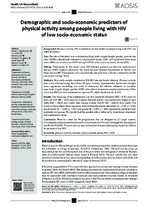Demographic and socio-economic predictors of physical activity among people living with HIV of low socio-economic status

View/
Date
2021Author
Mabweazara, Smart Z
Leach, L L
Onagbiye, Sunday O
Metadata
Show full item recordAbstract
Background: Physical activity (PA) is beneficial for the health of people living with HIV and
AIDS (PLWHA).
Aim: The aim of this study was to determine if age, body weight, height, gender, waist-to-hip
ratio (WHR), educational attainment, employment status, CD4+ cell count and body mass
index (BMI) can predict overall PA among PLWHA of low socio-economic status (SES).
Setting: Participants in this study were HIV-infected patients on first-line antiretroviral
therapy (ART) regimen offered by the South African National Department of Health, and
those not on ART. Participants were conveniently sampled from a list at a community health
care centre in Cape Town.
Methods: This study sample consisted of 978 HIV-infected South Africans. Physical activity
data were collected using the Global Physical Activity Questionnaire. Backward multiple
linear regression modelling was used to determine the relative influence of variables
(age, body weight, height, gender, WHR, educational attainment, employment status, CD4+
count and BMI) on total moderate-to-vigorous PA. Alpha level was set at 0.05.
Results: The mean age of the participants was 38.2 (standard deviation [SD] = 8.76) years for
men and 33.9 (SD = 8.53) years for women. Physical activity was significantly higher in men
(480.2 [SD = 582.9] min/week) than among women (369.35 [SD = 222.53] min/week). The
results of the multiple linear regression showed that educational attainment (β = 0.127; p = 0.00),
employment (β = −0.087; p = 0.01) and gender (β = 0.235; p = 0.00) significantly predicted total
moderate-to-vigorous PA. Gender had the greatest effect, followed by educational attainment
and employment status.
Conclusion: There is a need for PA programmes that are designed to (1) target women,
(2) strengthen programmes for education and promotion of PA and (3) engage the unemployed
into PA for PLWHA. Physical activity interventions for this particular group should be tailored
for persons of low SES.
